Last week I was busy wrapping up fall clean-up in the kitchen garden. The weather was warm, almost summer-like. Since then a storm rolled through, and provided some much needed rain.
Behind the storm late last week a cold-front brought us our first frost of the season. In mid-November. A full three weeks earlier than last year.
This week, in much cooler weather, I’m turning my attention back toward the native garden areas.
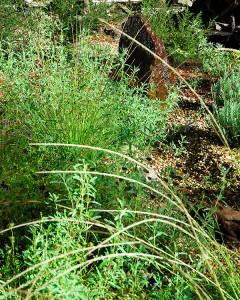
This bed has filled in tremendously in a very short space of time…the fountain is still back there, somewhere!
Unfortunately, the rain has still been scant this season. The little rain we’ve had though has been just enough to give me a hint as to how much weeding I’ll need to do over the coming months.
It’s not looking good is it?
Except for the explosion of weed seedlings, each fall we look forward to the return of the rain, because we usually have amassed a collection of native plants, and seeds, that need to find their way into the ground.
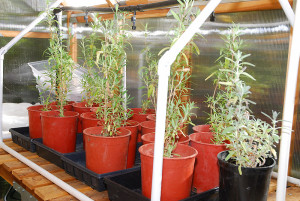
We’ve been holding a number of plants in the greenhouse for fall planting this season, including these young native sages
Fall is the best time for transplanting most California natives, as it’s the period of the year when we receive the most rainfall.
Although some are forgiving, a number of California native plants resent typical garden conditions, where water is provided regularly throughout the growing season. By planting in the fall, when natural rainfall amounts are highest, the plants have an opportunity to become better established before the warm, dry months of summer, which decreases their need for any supplemental irrigation.
This fall I have quite a large collection of native sages to get in the ground.
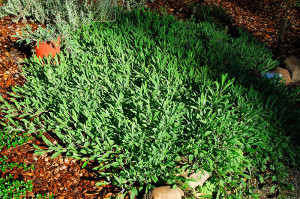
My new favorite ground cover, Salvia sonomensis ‘Fremont’s Carpet’. This is ONE plant! See the new plant in the orange pot at the upper left of this image…that’s how small this plant was just 6 months ago!!!
Some of the sages I propagated through cuttings last spring, others from seed, a few found their way home with me from fall plant sales. I’ve never met a native sage I didn’t like, but some of my favorites are Salvia leucophylla, S. mellifera, S. sonomensis, which I can’t say enough good things about, and some of the S. clevelandii hybrids that have done so well for us, including ‘Pozo Blue’, and ‘Allen Chickering’.
With the exception of a white sage (Salvia apiana) the gophers seem to leave these plants alone, and the deer don’t touch them either. As such I suspect I’ll be propagating even more of these sages over winter and spring as we still have a lot of areas to plant.
However, late October through mid-November is also the time to prune back young sage plants to prevent legginess. If we wait too long, we may sacrifice some of next spring’s blooms.
I also have a number of native buckwheat plants that I started from seed that are ready to go out, mostly Eriogonum latifolium, also known as chalk buckwheat, and Eriogonum fasciculatum, commonly known as California buckwheat.
If our winter turns out to be as dry as last year though, we’ll need to provide some supplemental irrigation this winter to get the plants off to a good start.
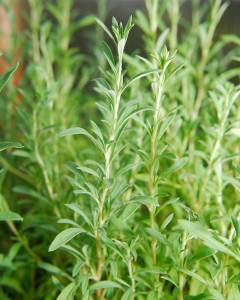
There are two dozen California buckwheat (Eriogonum fasciculatum) plants waiting outside the greenhouse to be transplanted this week
In addition to the sages and buckwheats, this season we’re also planting a few of the larger cultivars of Fremontodendron, or flannel bush.
Until now we’ve only planted the dwarf Fremontodendron ‘Ken Taylor’, which overall has been very happy in our sandy soils.
Unfortunately, one has been struggling immensely with the deer, and the other keeps getting lost behind a scrubby California bay laurel that keeps trying to sprout back since we cut it down.
The two cultivars we’ve chosen are Fremontodendron ‘San Gabriel’, and Fremontodendron ‘California Glory’. We’re hoping that these larger, faster growing specimens will be more quick to get established, and will grow large enough to spare their canopies from the deer once they’re mature. In the meantime though we’ll place some temporary deer fencing around them, through at least their first season, to give them the best chance of getting established without being consumed!
There’s one new addition that we’re experimenting with this year, that’s not actually a California native. This is a pitcher sage (Lepechinia hastata), but unlike our southern California native variety (Lepechinia fragrans), which we also grow here, this plant is actually native to Hawaii.
This was an impulse ‘I must have this plant‘ purchase at a recent plant sale. Anything in bloom this time of year tends to attract my attention. Don’t be fooled by its warm origins though, as this sage is hardy down to USDA zone 7, and the hummingbirds go simply berserk for the flowers, and it’s not even in the ground yet!
I’m looking forward to seeing how this sage does in our garden over the coming year.
Of the native plants that are already established in the garden, we actually still have a few blooms, even in mid-November.
The California fuchsias, including Epilobium canum ‘Catalina’, are still blooming, although Epilobium canum ‘Everett’s Choice’ seems to be mostly done for the season.
These plants have been so easy to care for, thriving on little supplemental water, and bloom reliably when little else does late in the season, so I’m adding two new cultivars this season. Epilobium californica ‘Calistoga’, which I’m hoping performs as well as the one in Town Mouse’s garden, and the silver-leaved variety Epilobium californica ‘Silver Select’.
The big surprise in the garden this fall has been our native goldenrod (Solidago californica). We planted some a couple of seasons ago, and quite honestly it seemed to disappear the first season. I wasn’t even sure it had survived. This fall though it finally made its presence known, and although the flowers are fading, they’re still providing a splash of yellow on the slope.
Another surprise is our native Sticky Monkeyflower (Diplacus aurantiacus). We have one plant under more cultivated conditions in front of the house, and that plant has been blooming sporadically since its peak bloom in July.
However, we also have a lot of wild plants in the non-irrigated areas of the property, and with just a little October rain, and plenty of sunshine, even they’ve managed to produce a few late season blossoms. This is the first time I’ve noticed them flowering in the fall months.
Just below those Monkeyflower, the Coyote Brush (Baccharis pilularis) I posted about recently has finally set a profusion of seeds. Literally thousands, and thousands, of seeds!
In a light breeze the seed fluff can be seen drifting across the entire orchard slope. It’s everywhere, and I’m frequently pulling them out of my hair, or off my clothes. This is precisely why the nursery trade only tends to sell male plants of this species! I suspect we may find more than a few volunteers sprouting around the property next spring. Just in case though, I’ll be propagating a few cuttings in the greenhouse over winter.
Because of our terrain, it’s easy for plants to get lost in our landscape, unless of course they’re either large, and/or planted in mass. Earlier this year I planted a few (then small) deer grasses (Muhlenbergia rigens). They’re no longer small, most of them in fact are at least as tall as I am, and they’ve done so well that I’m planting more this week. The deer don’t touch them, they need little care, and the resident spider populations seem to enjoy using their plumes as scaffolds for their webs.
Some less welcome native plants have been volunteering in some inconvenient locations recently, including this vibrant poison oak (Toxicodendron diversilobum).
The fall color is beautiful, and we leave it alone in the wild areas of the property as it’s an excellent habitat plant. However, to avoid the use of copious quantities of prescription strength anti-inflammatory lotions, this plant in the middle of the orchard is likely to be short lived.
Speaking of habitat, we do strive to make our gardens as appealing to wildlife as possible (perhaps with the exception of the gophers, and the voles). Sometimes though there are unintended obstacles for the wildlife to contend with, as this poor Hermit Thrush discovered when it tried to fly into the front garden, straight THROUGH the window in the dining room. In the time we’ve lived here, this is the first bird-hitting-the-window incident we’ve had.
After hearing a resounding ‘thud’ against the glass, I looked outside and found this poor bird had planted itself squarely on our deck. There it was laying flat out, head tilted, eyes half-closed, and wings spread. At first I feared the worst. I scooped it up, set it in a warm covered box, in a dark room, for just over half an hour. Fortunately this bird was just stunned, and only needed a safe place to recover. When I went back to check on it, despite our excellent hospitality, this Hermit Thrush was more than eager to leave, without even so much as a ‘thank you’.
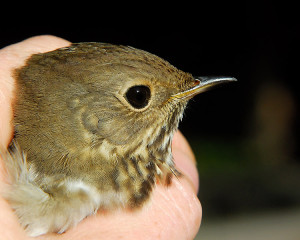
Once this Thrush was alert, and had a quick once over to be certain nothing was broken, we released it back outside
That’s alright though, we were just relieved that no permanent harm was done, and we can look forward to hearing its distinctive song echoing throughout our gardens next spring.

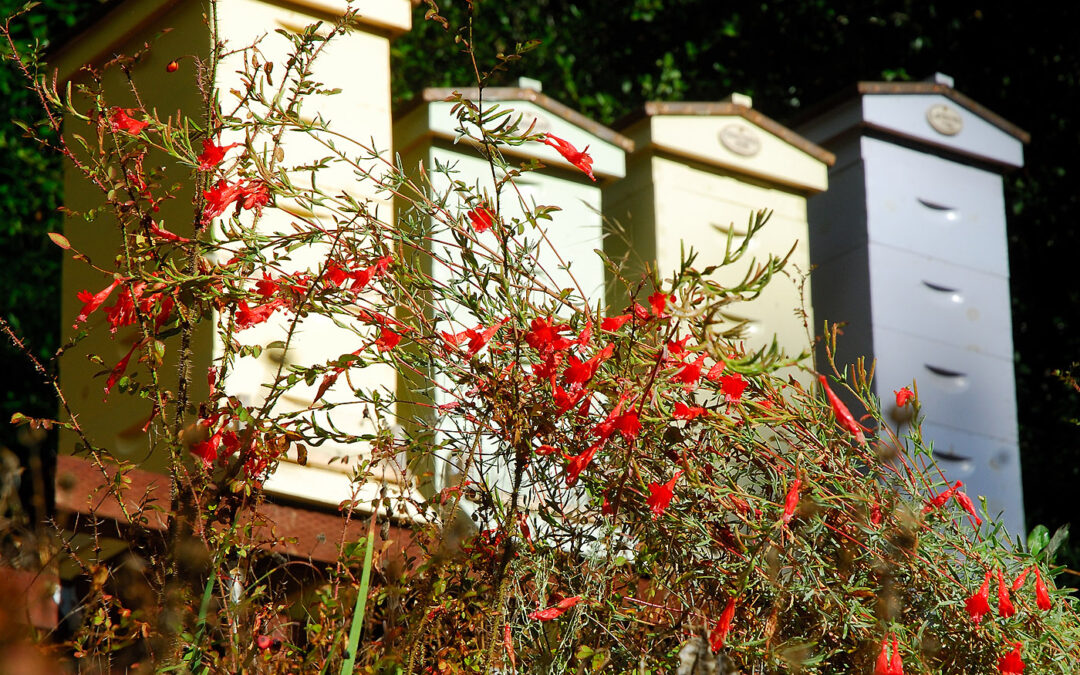
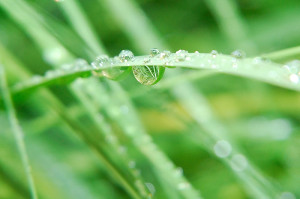
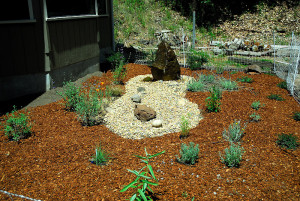
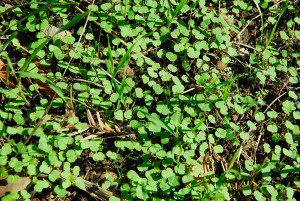
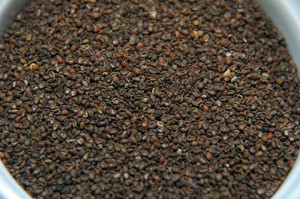
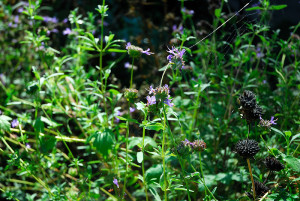
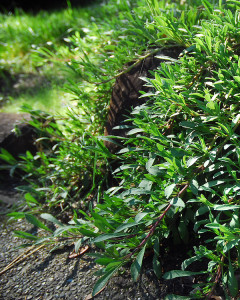
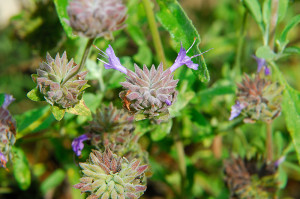
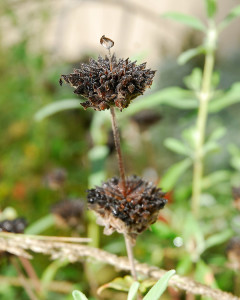

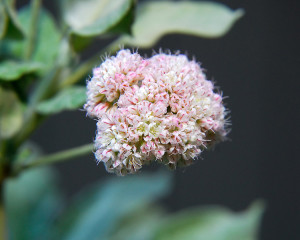

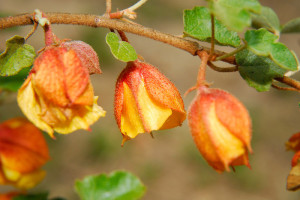
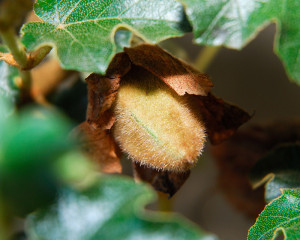
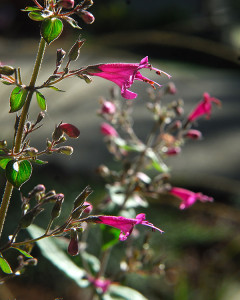
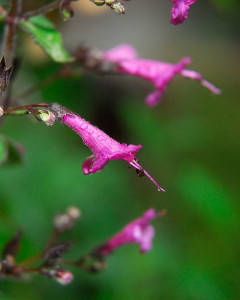
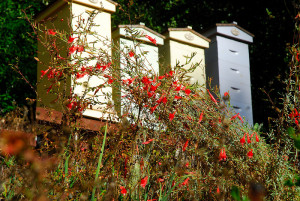
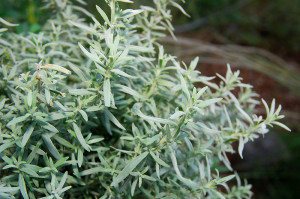
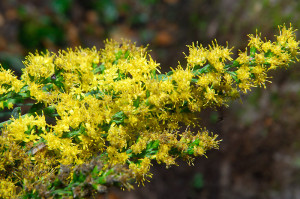
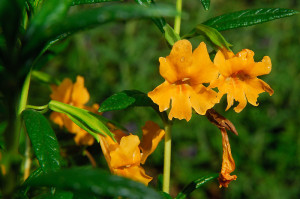
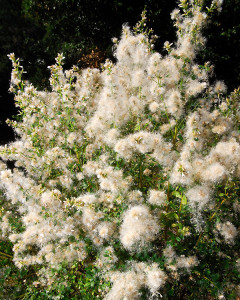
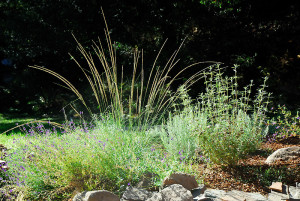
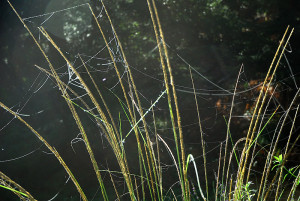
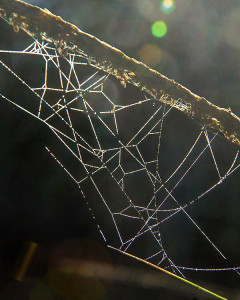
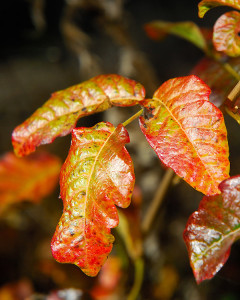
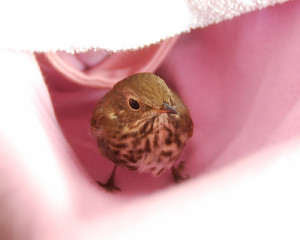







You have so much still blooming. I’m hoping the snow melts a bit more so I can capture a few blooms for GBBD this month. Heartwarming story about the sweet little thrush.
I’m sorry you have snow already. I’m struggling to adjust to our first days of frost. 😉
I love seeing the native garden grow up, Clare. You really have a lovely example for me of what can be done in a residential garden with fascinating, colorful natives and I’m soaking up all i can.
I’m recently overjoyed to see my first CA fuchsia blooming merrily, next to a Mexican marigold. Beware though…my deer grass started out slowly and is now a good solid three by three feet big. All of 2010 in my garden was spent transplanting things further out from each other, I had planted too closely!
Sometimes we get birds in our chimney flue, which then land down inside the wood stove. This used to make interesting ‘Cat TV.’ Distressing, but the birds so far have been smart enough to fly straight out the sliding door to freedom.
I admit, I was surprised by just how much the deergrass grew in its first season. I anticipated 4-5′ here, but expected it would take a while to achieve that size. Apparently it’s happy here! It doesn’t I won’t be editing the garden a little though, as I have a Ceanothus I need to move. I just want to be sure the rains are here in earnest before I try that though. I must’ve been quite a surprise the first time you found a bird in your woodstove! 😯
Clare,
Our golden rod did the same thing, kind of failed to make a good showing. The next year it spread wildly in the garden. Glad the Hermit Thrush was ok, they are one of my favorite brids.
It sounds like it may just take Goldenrod a season or two to establish itself. I’d always heard how rampant it could grow, so I was surprised when it disappeared for a while. I’m glad it’s back though 🙂
So much to comment on here – great post. I love the look of that Salvia sonomensis ‘Fremont’s Choice’ – I have a wall it would look good on. Re weed seedlings – I have a complicated situation on my experimental bed #1 where a lot of natives are reseeding – as are a lot of weeds! What to do? I will just have to wait on those. Re pruning back sages – Eek I have to get busy on that one – but I need to be really careful with my Winifred Gilman sage – last year I lost half of one and a good bit of another – maybe because I pruned too hard. I like the look of that pitcher sage! And I’m also thinking of planting more deer grass – I have some lovely ones growing too. I’m surprised the deer have eaten your flannel bush! You just never know with those pesky deer. My epilobium have not done so well – I have a hard time finding the right balance between sun/shade dry/bit of water for my local native ones. Finally – it is interesting that you have golden rod. I do not see it anywhere near me as I walk locally. But I visited a friend a ridge or two away and there it was all over a sunny south slope! Along with wild Epilobium. I brought a goodly amount of seed home! Thanks for a great post!
You bring up a good point. It does take a little while to figure out which seedlings are good, and which are bad!
Barbara, at Weeding Wild Suburbia recently did a good post on pruning young native sages, which prompted me to realize that now is the best time. I think, as with plants like Rosemary, the trick is to always prune into wood with growth, and not too far down.
I couldn’t believe the deer chomped poor Ken either. Every spring he’s been denuded of his leaves, and had the top trimmed. I either need to cage that Fremontodendron, or maybe even move it somewhere inside the deer fence this winter. I just know that moving them doesn’t always go well.
Hi Clare,
Lovely photos, and I love all your sages and grasses 🙂 Very pretty (definitely can’t have too much of either!)
Poor birdy, but glad to see it recovered well. We don’t often see/hear any birds hitting our windows, thankfully. But I know some people tens to get it quite often. Strange isn’t it?
We have a lot of large windows here, so I’m surprised this hasn’t happened sooner (that we know of anyway). I did wonder if now that the sun is so low in the sky if that has enhanced the reflection of some of the woodland. The poor thing was probably expecting to land on a branch, not crash into a window. 🙁
This post is a wonderful testimony to the great variety and beauty of native plants! Too many to comment on individually, except I am wondering why deer grass is called that if the deer don’t like it? Or maybe that IS the reason. It must feel wonderful to create this organic space, which is so beneficial to both humans and wildlife. I am glad the little bird is OK!
Thanks also, Clare, for your very kind comment on my last post! I truly appreciate it!
Ha! I wondered the same thing, and couldn’t find a good answer. Why is deer grass, ignored by deer, so named?! I’m just glad they leave it alone! I’ve contemplated planting an area of native grass pasture-land, and the only thing that held me back somewhat was the realization that the deer would likely eat it before our goats had a chance!
You’re very welcome for the comment by the way. I have serious envy in regards to your garden. The bones are well established, and you truly have an eye for harmonizing your garden with the natural elements, the bones, that already exist. Bravo!
Hi Clare, that’s a lot of native plants you are seeding, your stamina and hard work is incredible! I also posted our weeds in my other site POG, but here we don’t have very organized references about these weeds, so it is difficult for me to identify. I guess i just post them for the flowers. I don’t even know if they are native or introduced. I am envious with countries like yours that lists of native plants are available. We are just starting with our trees.
We’re very lucky here, Andrea, I agree. Online resources like Calflora have been very helpful for me while learning which plants here are native, versus introduced! 🙂
I am so glad the bird recovered. We have heard some taps on the windows but nothing very hard. You always have so much going on. And you do a great job of keeping it all organized.
It was definitely the loudest ‘thud’ I’ve heard here. It hasn’t been an issue here before, but if it happens again I need put some sort of decals, or streamers over that window to make it more obvious.
So many great looking plants! I have yet to meet a salvia I didn’t like. That is one impressive specimen you have there! The pitcher sage looks so pretty as well. I love all the spider webs in the grass – so pretty! I’m glad the bird was okay!
That Salvia sonomensis has more than surpassed my expectations! I was a little afraid it was going to get too much south sun, as it’s quite exposed, and gets reflected heat off the driveway. It’s growing great though, and actually looks happier than some of the others I planted at the same time. Definitely something I’ll plant more of!
I do so love that new front garden…the contrasti8ng color of the mulch and the plants…so many beautiful natives in CA…especially those sages.
The mulch did look good, while you could see it. You can still see some of it, but it’s amazing how much everything has grown. There’s a lot less redwood mulch visible than there was 6 months ago! 😉
Clare I am now repeating, I don’t live in California, I don’t live in California, I don’t live in California. Zonal denial is a tough habit to kick. ….hmmm, maybe just one sticky monkeyflower if I protect it…no, stop Tom stop, step away from the tender perennials…
Actually Tom, that Sticky Monkeyflower is probably cold-hardy enough for where you are (what are you, USDA zone 8?). It’s good at least to zone 7. However, that said, my bigger concern would be rain. This is one tough drought-resistant cookie. It’s probably less upset with too much water than some of our sages, but would still probably demand very well draining soil. If you could find one, it wouldn’t hurt to try 😉
Your new native garden looks just wonderful. What a lot of growth in just one season. As always I’m impressed by the amount of native plants you have on your property. Sounds like this is a really busy time of year for you, almost like spring is here. That pile of wildflower seeds made me smile. It’s addicting collecting seed isn’t it?